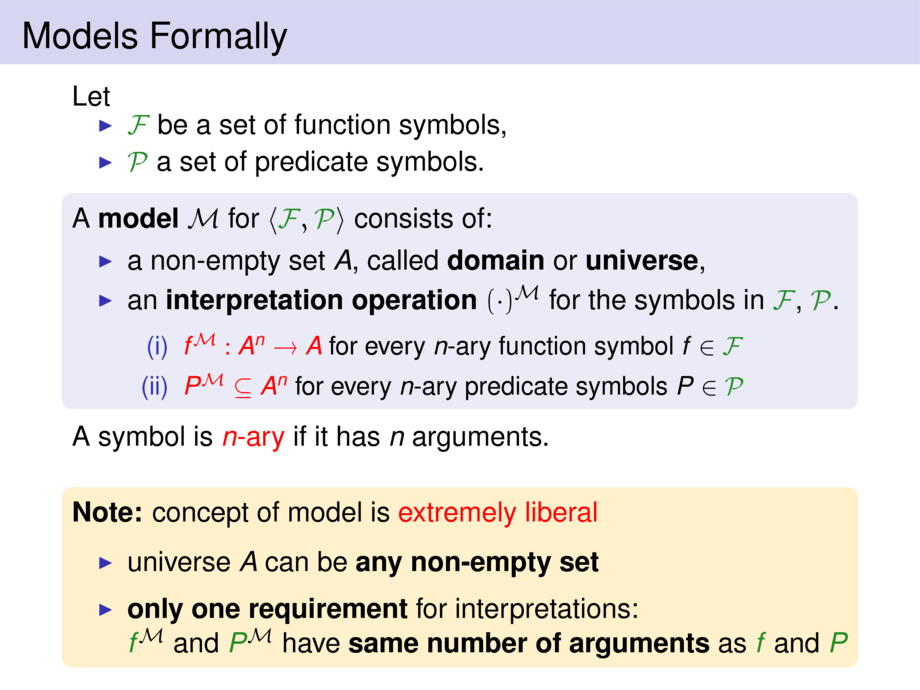



































































































56/270
\begin{frame}{Models Formally}
Let \vspace{-.5ex}
\begin{itemize}\setlength{\itemsep}{0ex}
\item $\asetfuncs$ be a set of function symbols,
\item $\asetpreds$ a set of predicate symbols.
\end{itemize}
\pause
\begin{block}{}
A \emph{model} $\model{\amodel}$ for $\pair{\asetfuncs}{\asetpreds}$
consists of:
\begin{itemize}
\item
a non-empty set~$\model{\adomain}$, called \emph{domain} or \emph{universe},
\item
an \emph{interpretation operation} $(\cdot)^{\model{\amodel}}$
for the symbols in $\asetfuncs$, $\asetpreds$.
\begin{enumerate}[(i)]
\item
\alert{$\interpretin{f}{\model{\amodel}} : A^n \to A$}
for every $n$-ary function symbol $f \in \asetfuncs\,$
\vspace*{0.75ex}
\item
\alert{$\interpretin{P}{\model{\amodel}} \subseteq A^n$}
for every $n$-ary predicate symbols $P \in \asetpreds$
\end{enumerate}
\end{itemize}
\end{block}
A symbol is \alert{$n$-ary} if it has $n$ arguments.
\pause
\only<-7>{
\begin{exampleblock}{}
\begin{itemize}\setlength{\itemsep}{0ex}
\item
\alert{$\interpretin{\const{c}}{\model{\amodel}} \in \model{\adomain}$}
for nullary function symbols (constants) $c \in \asetfuncs$
\pause
\item
\alert{$\interpretin{f}{\model{\amodel}} \funin \model{\adomain} \to \model{\adomain}$}
for 1-ary (unary) symbols $f \in \asetfuncs$
\pause
\item
\alert{$\interpretin{f}{\model{\amodel}} \funin \model{\adomain} \times \model{\adomain} \to \model{\adomain}$}
for 2-ary (binary) symbols $f \in \asetfuncs$
\pause
\item
\alert{$\interpretin{P}{\model{\amodel}} \subseteq \model{\adomain}$}
for 1-ary (unary) predicate symbols $P \in \asetpreds$
\pause
\item
\alert{$\interpretin{P}{\model{\amodel}} \subseteq \model{\adomain} \times \model{\adomain}$}
for 2-ary (binary) predicate symbols $P \in \asetpreds$
\end{itemize}
\end{exampleblock}
}
\pause[8]\bigskip
\begin{goal}{}
\emph{Note:} concept of model is \alert{extremely liberal}
\begin{itemize}
\smallskip
\item
universe $A$ can be \emph{any non-empty set}
\smallskip
\item
\emph{only one requirement} for interpretations:\\
$\intin{\sfunc{f}}{\model{\amodel}}$ and $\intin{\spred{P}}{\model{\amodel}}$
have \emph{same number of arguments} as $\sfunc{f}$ and $\spred{P}$
\end{itemize}
\end{goal}
\vspace{10cm}
\end{frame}

